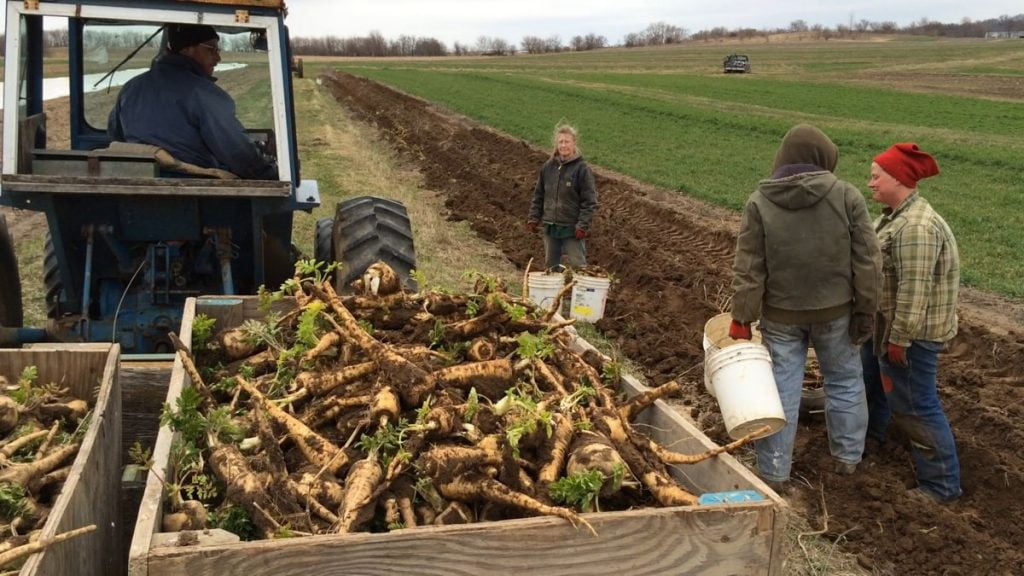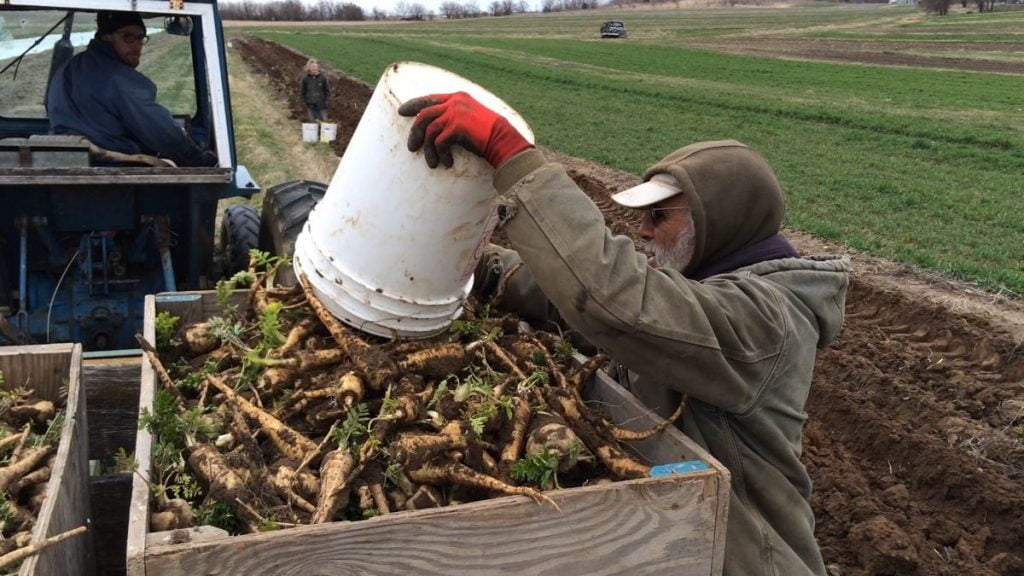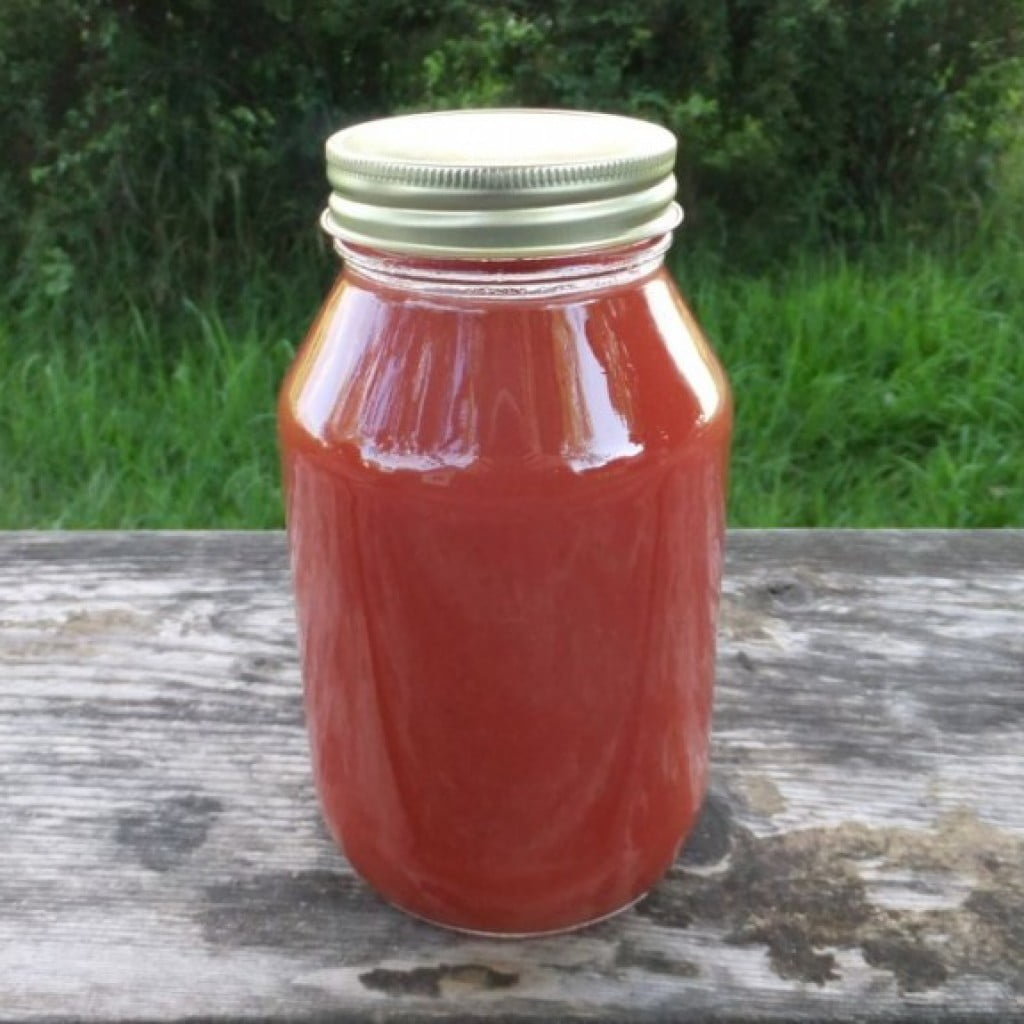Welcome!
- On: May 18, 2016
 6
6
Welcome to our CSA! Deliveries begin this week for weekly members and for green every-other-week (EOW) members. Purple EOW, your first delivery is next week, May 26/27 (Thursday/Friday sites).
Things you need to know.
♦ On Thursday, we deliver CSA boxes to Evansville, Fitchburg, Madison, McFarland, Middleton and Oregon.
♦ On Friday, we deliver CSA boxes to Brookfield, Janesville, Mequon, Milwaukee and Wauwatosa.
♦ We post this newsletter/blog each Wednesday night, with the list of veggies for the week, quantities, information about storage and preparation, news of the farm, recipe list, and a forecast for the next week’s box. We alert you by email on Wednesday night once the newsletter is posted and ready to read.
♦ Want earlier notice of what will be in the box? Check the sidebar on our website homepage around 7 p.m. on Wednesday night. I’ll post the list under “Box Contents.” I also provide a tentative list for the following week in the Veggie List section of this newsletter. The list is rarely complete but the items listed are ones we feel confident about.
♦ EOW and weekly members, we assume you read all the newsletters, even on your “off” weeks. This newsletter (and our emails to you) are our means to communicate with you.
♦ The first few boxes of the season are often the lightest. EOW members, do not worry that you have signed up for the wrong share. Our deliveries get heavier and more abundant as the season progresses.
♦ We will sometimes write “OR” in the produce list, e.g. green leaf OR red bibb lettuce. You will receive one of these crops. We will pack the same crops for all the members at your site. Therefore, all the boxes at your site are identical. Please don’t open other members’ boxes.
Which of this week’s veggies were planted this spring?
Asparagus? Nope, we planted our asparagus fields in 2004 and 2008.
Rhubarb? No, this is another long-established perennial. In fact, we’ve been growing and dividing these rhubarb crowns since 1988. We inherited the plants from another farmer’s 1970s-era planting. If you’ve ever divided rhubarb, then you know it forms thick underground crowns. Our tool of choice for dividing crowns is a sharpened shovel. It’s not a delicate job. Rhubarb is tough.
Green garlic was planted in the fall, rooted quietly under its winter mulch, then grew shoots this spring.
Carrots and parsnips are both from last year. See below.
Tomato juice was bottled with our tomatoes last summer when they were at their peak.
Lettuce, spinach, Asian mustard and radishes? Yes, these were all planted this year.
Now you understand our strategy to fill the early CSA boxes!
Parsnips
The parsnips spent the winter in the ground. They were planted last spring and tended all summer. We harvested most of the parsnips last fall, but left these for spring harvest. Parsnips sweeten over the winter and are fabulous once spring arrives.


Parsnip harvest in April. We harvested these by hand instead of using our root harvester. The harvester needs tops to grab, and the parsnips lose their leaves over the winter.
Carrots
We fought off hordes to save these carrots for you. Our harvest last fall was so massive that we supplied carrots to our store customers into late April. That’s our longest carrot sales season yet. The quality was very good so demand stayed high. This was a mixed blessing. It was great to have that many carrots to sell but the work overlapped with our start to the season. We found ourselves juggling greenhouse work with washing stored crops. We were ready to move on to this year’s plantings.


We celebrated the last carrot washing with a bottle of champagne. It’s an annual tradition. No fancy stemware for us. Look at the green grass! That tells you how late in spring we finally finished our storage crops. We usually wrap up a month earlier.
Veggie List and Veggie Notes (May 19/20, 2016, week #1, green EOW)
Read this section each week for specific information about the produce. For example, see our notes below about how to extend the storage life of your lettuce and spinach. I provide detailed notes on each crop only the first week we pack it. This is another reason to read our newsletter weekly.
Asparagus, about 1.5 lb
Red leaf lettuce
Green leaf OR red bibb lettuce
Spinach, 1 small bunch
Asian mustard greens, 1 medium bunch
Salad radishes, 1 bunch
Carrots, 2 lb
Parsnips, 1 or 2
(in the same bag as the carrots)
Green garlic, 1 bunch
Rhubarb, 2 lb
Tipi tomato juice, 1 quart
Next week’s box will probably contain asparagus, rhubarb, potatoes, lettuce, spinach, radishes, green garlic and some kind of spring green. Watch next week’s newsletter for the final list.
Asparagus – Enjoy this spring treat! Your asparagus will be green or purple. The purple variety turns dark green when cooked. Its flavor is almost identical to normal green asparagus. Wash your asparagus thoroughly to remove hidden grit. Submerge in water, soak briefly, then swish vigorously and pull out of the water with the tips pointing down. The draining action helps pull the grit out of the asparagus tips. Repeat several times.
Storage: Asparagus is perishable, so eat it as soon as possible. Store it in the paper bag we packed it in, and wrap loosely in a plastic bag. The paper bag protects the asparagus tips from direct contact with the plastic bag. The plastic bag keeps the asparagus from wilting.
Preparation: We snap our asparagus at harvest, rather than cutting. Therefore, there is no need to snap the stalks to remove fibrous ends. For the same reason, it is not necessary to peel the asparagus stalks. It’s OK to trim the end a bit.
Cooking: If your asparagus stalks vary greatly in size, you will want to cook the thicker ones longer. Put the asparagus in a steamer pot over water. Alternatively, you can lay spears flat in the bottom of a broad pan, with ½ inch of water. Cover and steam over medium heat until just tender. Use two forks or a spatula to turn the asparagus during cooking, rotating the bottom spears to the top. Drain and serve. Also excellent broiled or grilled. Good dressed with vinaigrette, or simply with lime juice, salt and pepper.
Lettuce and spinach – Wash your greens to remove grit splashed into the heads by rain. Cut to the size you like, submerge in water, swish gently, then pull from the water and drain in a colander. Some weeks, you will need to repeat in fresh water.
Storage hint – To extend the storage life of your tender greens, wash them, dry in a salad spinner, then store in a dry container or bag. Lettuce and spinach last much longer when handled this way.
Asian mustard greens (bundle of green leaves. Color is lighter green than the spinach) – These are young and tender and you can eat the whole plant; buds, stems and leaves. They are a great addition to salads because they are so mild. At this young age, they wilt substantially if cooked, so keep the cooking to a minimum. Add at the last minute to soup or sautés. We’re planning mustard green and asparagus quiche for this weekend.
Carrots – These are in great shape, considering we stored them all winter. Refrigerate and eat soon.
Parsnips (looks like a big white carrot) – Spring-dug parsnips are exceptionally sweet, a legacy of exposure to cold over the winter. When cooked, parsnips are sweet and starchy. Brown them so the sugars caramelize, to give the best flavor. We have only a small amount to share so be creative. Ideas:
– Oven-roast the carrots and parsnips together.
– Use in soup.
Green garlic (looks like scallions, tastes like garlic) – Last fall, we planted garlic cloves that grew into the stalks we harvested this week. If left to grow until mid-summer, the slim white bulb on this week’s garlic would divide and form the usual cluster of cloves in a garlic bulb. Green garlic is more pungent than scallions, so slice thinly and use sparingly when raw. It mellows when cooked. Chop and add to any cooked dish that would benefit from garlic. Use the white bulbs and pale green stems. Avoid the dark green stems and leaves, as these are fibrous.
Rhubarb – Refrigerate in a plastic bag. FYI, 2 lb of rhubarb yields 6 – 6.5 cups when chopped.
Stewed rhubarb: This is the simplest way to prepare rhubarb. Chop rhubarb into one inch chunks. Stir over medium heat with a small amount of water in the bottom of the pan. The rhubarb will release moisture as it cooks. Stew until it softens and falls apart. Sweeten to taste with honey or sugar. Eat warm on its own, over vanilla ice cream, on pancakes, etc.
Tipi tomato juice – We had this juice bottled from our tomatoes last summer. It’s a great way to capture ripe tomatoes at peak season, at a moment when we are swimming in tomatoes. Drink it or try making an easy soup with the tomato juice, carrots, and parsnips. Add minced green garlic and spinach or mustard greens at the very end.
Storage: Store the juice out of sunlight at room temperature when unopened. Refrigerate after opening. The juice is already seasoned so don’t add salt if you cook with it.
Ingredients: organic tomatoes from Tipi Produce, salt, organic garlic, organic onion, organic black pepper. I’ve posted the nutritional information here.
Recipes from chef Pat Mulvey at Local Thyme
Comforting Classics
Asparagus and Radish Greens Frittata with Gruyere
Cinnamon Crisp Rhubarb Muffins
Roasted Parsnip, Carrot and Tomato Soup
Shredded Radish and Carrot Salad with Carrot Ginger Dressing
Outside the Box Recipes
Asparagus with Tapenade Vinaigrette
Rhubarb Spritzer
Mustard Greens Salad with Frizzled Parsnips and Rhubarb Vinaigrette
Hearty Grain and Egg Salad with Green Garlic Dressing
Quick and Easy Meal




